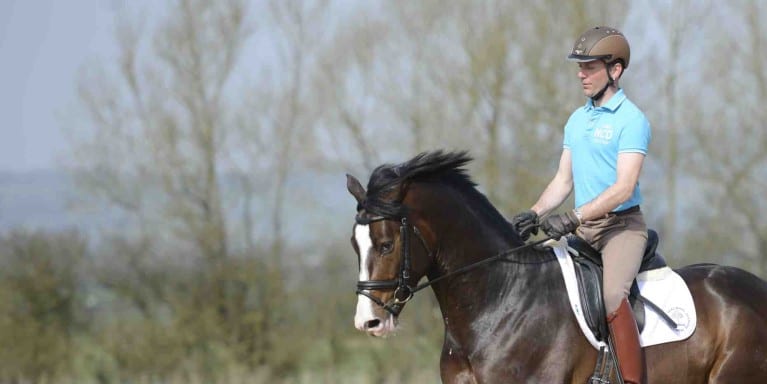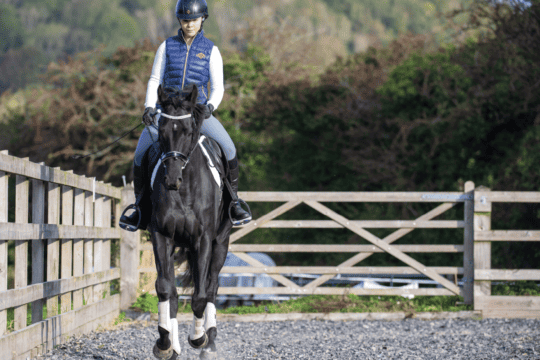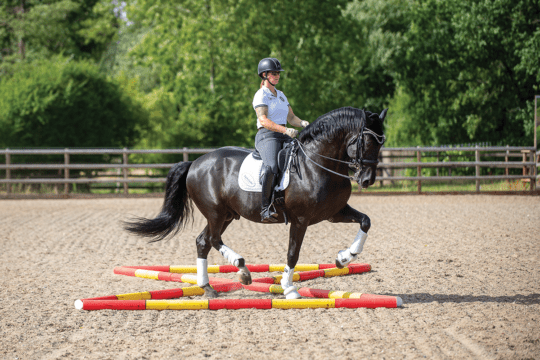Lorraine Jennings explains some simple exercises to improve your horses paces, keep his interest, and help him to work through his back.

Exercise 1 – keep his interest
Trotting endless circles while you try to find a balance between your leg and hand is frustrating – and dull! There’s no better way to lose your horse’s attention. Transitions will inspire him and get him focused. If he’s working freely forward, he’ll swing through his back, allowing you to contain him between your leg and hand.
Try riding direct transitions between halt and trot, and trot and halt. The upwards transitions will create energy, but be careful not to lose it in the downward transitions. It may seem illogical to push on to slow down, but your horse needs his hocks underneath him to balance – push them there.
Exercise 2 – push to slow down
Be precise with your transitions. In trot, go large and ride a direct transition to halt at E and B. Don’t think of halt as stop – think of it as a stationary pace. It needs to be ‘active’. Your approach to it has a huge effect on your horse. Don’t slouch – sit up and carry yourself, it’s what you expect him to do. And focus! You want his attention, so make sure he has yours. Keep hold of your contact and keep your leg on, so that he’s waiting for your next aid.
As you approach each marker, use both legs to keep your horse’s hocks underneath him. Tighten your fingers around your reins. As he halts, maintain the pressure from your legs and your hands. Make sure he stands completely still before allowing him to trot again, by relaxing your fingers and giving him a nudge with both heels.
Make it more challenging….
As your transitions improve, start to reduce the distance between them. Ride one at every marker around the school. The short bursts of trot between halts will keep your horse focused and active. They’ll make sure you ride forward, too. Many riders unwittingly take their leg off in a downward transition, but with this exercise you’ll be so busy thinking about trotting on again, you’ll find your leg stays on. The result? Your contact will contain his energy, he’ll sit back on his hocks and his back will round.
Exercise 3 – forward to canter
It would be easy to move on into canter and lose the impulsion – it naturally feels more forward – but forward doesn’t always mean power. That’s something you have to create.
Canter a 20m circle at E/B. Introduce 10m circles at the E marker, the B marker and also as you cross the centre line. If your horse is young, increase the size of the circles to 12-15m. Small circles keep you riding forward and the horse working harder through his back.
Your position is important on the circles to keep your horse’s quarters behind his shoulders. If he’s crooked, any power from his hocks is wasted. Everything you do with your hands he’ll mirror with his shoulders. Drop one or move them apart and he’ll do the same – he’ll fall in or out. Keep your hands together and use both legs to push his quarters behind them. Turn your body onto the curve of the circle and you’ll find he does the same. The fewer aids you use, the easier it is for him to understand.
Exercise 4 – perfect timing
Where and how you ask for trot can have a dramatic effect on your transition. Back off the transition and your horse’s hocks will stop working, and he’ll flatten and run. Asking at E or B makes matters worse, as the long side opens out in front of him. Small circles can help to slow him down, but they don’t encourage you to ride forward.
On a 20m circle, ask for trot as you cross the threequarter line. On the centre line, change the rein onto a 10m circle. It’s difficult, but it isn’t impossible. Your first few attempts may feel a bit ungainly, but stay positive and ride forward. Any horse can do it, but it’s up to you to tell him that he can. It’s a good exercise to make you ride through the transition and it highlights how little you usually do.
One at a time…
These exercises are great to get your horse connected, but they’re hard work, too. Don’t overdo it by heading out full of enthusiasm and trying them all in one session – take your time. Trying too hard was the cause of the problem – don’t make the same mistake again! Good luck and enjoy your schooling.















